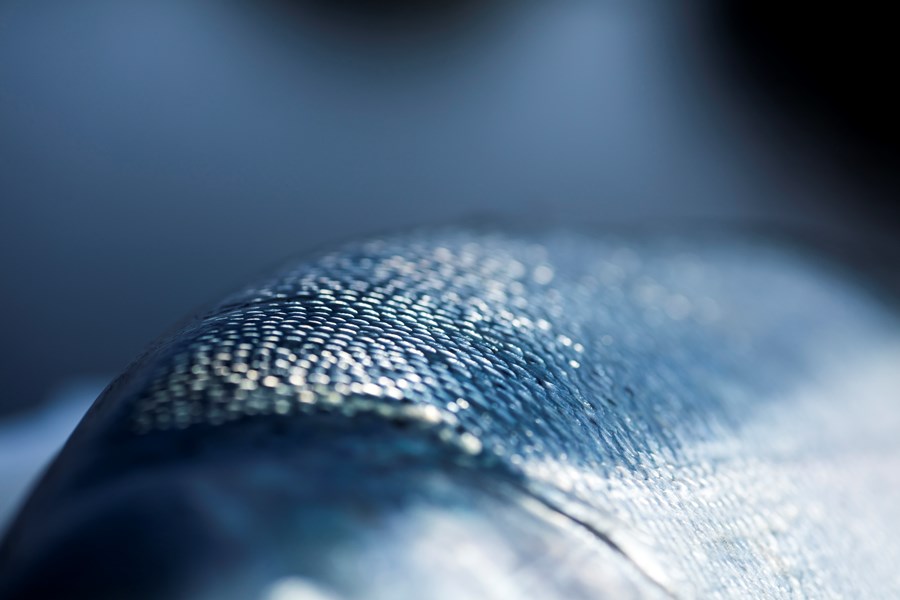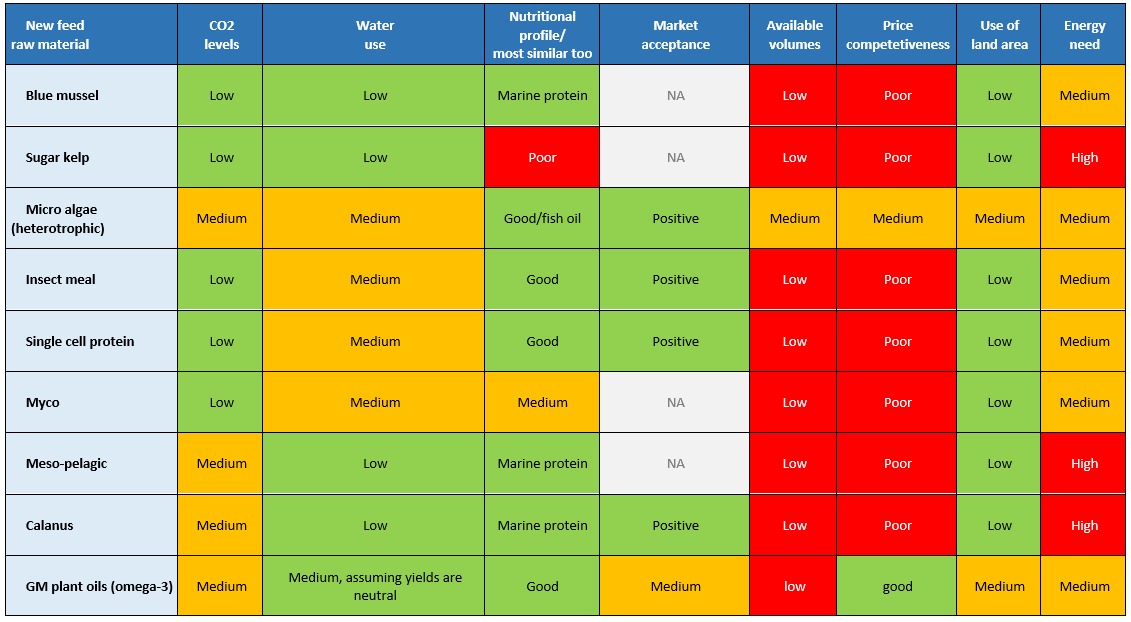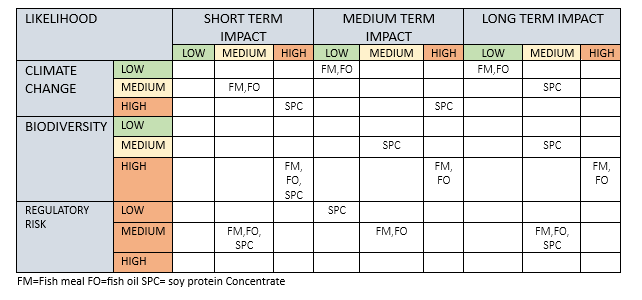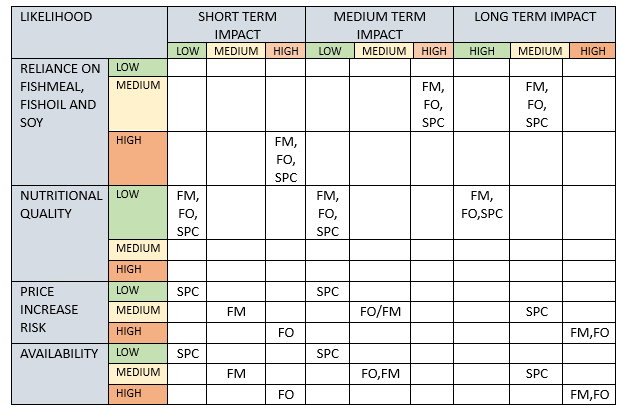
The Group work actively to further the development of sustainable fish feed.
Lerøy Seafood Group has taken an active role in influencing the further development of feed composition to ensure premium product quality, in a sustainable way.
Lerøy is working with feed suppliers on exploring and developing innovation to be able to choosethe most sustainable feed sources in terms of greenhouse gas emission reduction.
Our fish feed ingredients are to be sourced from sustainable, ethical and traceable sources.
A growing population needs more food. Only between 2 and 5 percent of the protein we eat today comes from the sea. Seafood is a healthy product that the WHO recommends an increased intake of, and as more and more species of wild fish are managed sustainably today, an substantial increase in seafood consumption will have to come from aquaculture.
PER = FCR X % feed protein, divided by % protein in culture species
| PER LERØY 2022 = 2,14 | |
| FCR= 1,14 | Source: Lerøy bFCR number |
| feed protein 37,5 | Source: Average feed content delivered Lerøy |
| % protein in salmon 20 | Source: Sjømatdata, IMR, whole farmed salmon |
Salmonids in particular demands a feed of the highest quality. They need to be protein dense, have high fat and close to no carbohydrates. These raw materials are also used in other types of feed for other aquatic species, petfood, chickens and to some extent pigs. This drives the raw material demand on the world market, and both access and price of raw materials are highly subject to change.
It is also essential to ensure that the raw materials do not contain substances that can harm the marine environment during production at sea, or that we source raw materials from unsustainable fisheries. The vegetable raw materials have been subject to a risk assessment, and the products with high ESG risk have received sustainability certification. Some raw materials have a larger carbon footprint than others and LCA standardisation is still maturing. Raw materials are produced all over the world and in some countries it is important to ensure that UN human rights are respected.
More than 90% of all raw materials used in Lerøy`s fish feed are imported to Norway. The raw materials used in our feed come from both marine species and vegetable species and are produced all over the world. This can lead to an increased negative risk in relation to the environment, economy and people involved through our value chain. It is therefore important for Lerøy to have an increased focus on supplier management towards our feed suppliers ensuring proper management of various species, no deforestation and proper use of fresh water when producing raw materials on shore and to secure the lowest possible greenhouse gas emissions for the individual raw material.
Fish feed is the input factor that contributes the most to our greenhouse gas emissions and would be significant in relation to potential negative effects on the economy if a tax on greenhouse gas emissions were to be introduced. Changing the composition of raw materials to achieve climate targets could cause the company increased costs.
Some of the countries that produce raw materials are listed with a potential risk of negative impact on human rights. It is therefore of great importance for Lerøy that our feed suppliers carry out audits and that they ensure that the Group's supplier code of conduct is observed.
Our fish feed ingredients are to be sourced from sustainable, ethical and traceable sources.
Marine raw materials shall originate from responsibly regulated fisheries, with individual species governed in accordance with the regulations laid down by national and international authorities and quotas specified on the basis of scientific recommendations.

Throughout the year, we have meetings, email correspondence and conversations with various stakeholders where we have presentations and discussions related to the areas where we have or can have a potential impact.
We also attend conferences and meetings where we meet and discuss. Through this form of dialogue, we gain insight into what stakeholders are concerned with and feedback on what they think about the way we work, measures we have initiated and what they think we should focus on going forward. Through various forms of benchmark surveys, we also receive feedback on what stakeholders think about our measures and their implementation.
Lerøy has close follow-up and collaboration with its own feed suppliers through a constant dialogue and meetings. We have scheduled quarterly meetings but also a number of different meetings in addition.
Lerøy has made active choices in relation to raw material choices by implementing new raw materials such as insect meal and microalgae in the feed. We have also chosen to take out various raw materials that we do not want as part of our feed. Examples of this are palm oil, Ethoxyquin, salmon oil, GMO raw materials and flour and bones from land animals. Lerøy carries out R&D focusing on new raw materials for feed such as kelp and mussel meal.
Working with new and novel feed ingredients is important, but not enough to reach our goals. We are therefore looking into and changing the sources/production methods of our existing basket. Demanding that all soy products in Brazil has to come from an deforestation free value chain is one of these examples, and in 2022 we have started a new exciting endeavour.
Together with our feed producer Lerøy is investing in both regenerative agriculture and new sources of soy produced with less fertilizer, less processing and with a higher standard on land use. This positively affects our CO2 emissions, but also have an positive effect on water use and biodiversity impact.
Lerøy has together with our feed producers and the independent research institute Sintef, completed a raw material climate risk analysis. We have looked into availability, CO2, pricing, climate risk, water usage etc. This tool is to be continuously updated with new raw materials, to facilitate a factual and holistic decision making tool.
By taking part in “the Aquaculture Dialogue on Sustainable Soy Sourcing in Brazil”, Lerøy has been instrumental in ensuring that the three suppliers of soy protein concentrate are now 100% free of deforestation and land alteration activities (DCF).
A number of businesses are involved in the production of raw materials, as in other industries, and Lerøy aims to ensure that these all comply with our requirements laid down in our Code of Conduct, that they utilise a monitoring system so that all production information can be traced back to them and measured, and that the raw materials are safe for both the fish and the people who eat the fish.
In some countries where raw materials are produced, water can be a scarcity factor. Lerøy have a collaboration with our suppliers of fish feed regarding water risk Management. It is important to determine the full risk profile and understand the actions needed to minimize risks linked with water use related to agriculture raw materials. This collaboration has resulted in a water conservation and efficiency plan for each supplier, including but not limited to risk assessments based on WRI Aquaduct, monitoring water stress, KPI`s to reduce withdrawals and increase water quality and preventive actions.
Policy: Fresh water use
A fish feed that is tailored for both fish and environment. A total-cost optimised feed that meets all our requirements for our ESG ambitions, and which at the same time gives our fish the nutritional backpack it needs to thrive and grow.
We divide the ingredients into two groups:

| Name | Quantity Used (MT) | Percentage in fishmeal | MarinTrust Lerøy | MSC Lerøy | FIP MT | FIP MSC | |||||||||||||||||||||||||||||||||||||||||||||||||||||||||||||||||||||||||||||||||||||||||||||||||||||||||
|---|---|---|---|---|---|---|---|---|---|---|---|---|---|---|---|---|---|---|---|---|---|---|---|---|---|---|---|---|---|---|---|---|---|---|---|---|---|---|---|---|---|---|---|---|---|---|---|---|---|---|---|---|---|---|---|---|---|---|---|---|---|---|---|---|---|---|---|---|---|---|---|---|---|---|---|---|---|---|---|---|---|---|---|---|---|---|---|---|---|---|---|---|---|---|---|---|---|---|---|---|---|---|---|---|---|---|---|---|---|---|---|
Source: Whole fish
|
|||||||||||||||||||||||||||||||||||||||||||||||||||||||||||||||||||||||||||||||||||||||||||||||||||||||||||||||
Source: Trimmings
|
|||||||||||||||||||||||||||||||||||||||||||||||||||||||||||||||||||||||||||||||||||||||||||||||||||||||||||||||
Total
|
|||||||||||||||||||||||||||||||||||||||||||||||||||||||||||||||||||||||||||||||||||||||||||||||||||||||||||||||
| Name | Quantity Used (MT) | Percentage in fishoil | MarinTrust Lerøy | MSC Lerøy | FIP MT | FIP MSC | |||||||||||||||||||||||||||||||||||||||||||||||||||||||||||||||||||||||||||||||||||||||||||||||||||||||||
|---|---|---|---|---|---|---|---|---|---|---|---|---|---|---|---|---|---|---|---|---|---|---|---|---|---|---|---|---|---|---|---|---|---|---|---|---|---|---|---|---|---|---|---|---|---|---|---|---|---|---|---|---|---|---|---|---|---|---|---|---|---|---|---|---|---|---|---|---|---|---|---|---|---|---|---|---|---|---|---|---|---|---|---|---|---|---|---|---|---|---|---|---|---|---|---|---|---|---|---|---|---|---|---|---|---|---|---|---|---|---|---|
Source: Whole fish
|
|||||||||||||||||||||||||||||||||||||||||||||||||||||||||||||||||||||||||||||||||||||||||||||||||||||||||||||||
Source: Trimmings
|
|||||||||||||||||||||||||||||||||||||||||||||||||||||||||||||||||||||||||||||||||||||||||||||||||||||||||||||||
Total
|
|||||||||||||||||||||||||||||||||||||||||||||||||||||||||||||||||||||||||||||||||||||||||||||||||||||||||||||||
| VEGETABLE PROTEIN | ||
| Soy protein concentrate | 18 % | Russia, Brazil, Ukraine, Argentina, Serbia, Croatia |
| Faba beans | 9 % | France, Poland, UK, Netherlands, Poland |
| Wheat gluten + wheat | 11 % | Germany, Uk, Netherlands, Belguim, Lithuania, France, Poland, Italy, Ukraine |
| Sunflower meal | 4 % | Russia, Ukraine, Hungary, Kazakhstan, |
| Pea protein | 0 % | China |
| Guar meal | 5 % | India |
| NOVEL PROTEINS | ||
| Insect meal | 0,01 % | Holland, France |
| Micro algea oil | 1 % | USA, Brazil |
| Vegetabile oils | ||
| Vegetabile oils | 16 % | Russia, Lithuania, Germany, Ukraine, Kazakhstan, Switzerland, Belgium, Netherlands |
| Other raw materials | ||
| Other11 | % | Global |
| Fish meal | 15% |
| Fish oil | 11% |
| Soy protein concentrate | 18% |
| Faba beans | 9% |
| Wheat gluten + wheat | 11% |
| Sunflower meal | 4% |
| Pea protein | 0% |
| Guar meal | 5% |
| Insect meal | 0,01% |
| Micro algea oil | 1% |
| Vegetable oils | 16% |
| Other | 11% |
Improving the FFDR ratios is an important KPI for Lerøy. The implementation of organic Debio certified salmon, in addition to a turbulent year in the commodity market has made it necessary to include more marine raw materials. We are looking to unlock the synergies with our own trawlers to gain access to more trimmings.
Kilogram of industrial fish per kilo of salmon produced used in the fishmeal and oil in fish feed
|
FFDR salmon |
2022 |
2021 |
2020 |
|
FFDRm |
0,53 |
0,45 |
0,39 |
|
FFDRo |
1,60 |
1,65 |
1,7 |
The data is verified by an independent third party.
| FFDRm= ( %fishmeal in feed from forage fisheries)* (eFCR)/24 |
| FFDRo=( % fishoil in feed from forage fisheries) * (eFCR)/5,0 eller 7,0 depending on species |
PER = FCR X % feed protein, divided by % protein in culture species
| PER LERØY 2022 = 2,14 | |
| FCR= 1,14 | Source: Lerøy bFCR number |
| feed protein 37,5 | Source: Average feed content delivered Lerøy |
| % protein in salmon 20 | Source: Sjømatdata, IMR, whole farmed salmon |
|
|
2022 |
2021 |
2020 |
2019 |
|
Share of marine raw materials % |
29 |
33 |
20 |
22 |
|
Share of vegetable raw materials % |
71 |
67 |
80 |
78 |
| 2022 | 2021 | 2020 | 2019 | |
| Average emissions per kg feed produced for the Group | 2,02 | 2,08 | 2,30 | 2,32 |
More sustainable soy farming practices are the main contributors to reduced greenhouse gas emissions per kg feed. We have also started to adopt regenerative agriculture methods in vegetable protein/oil production, and a stricter selection of sub-suppliers based on their emissions performance.
Lerøy has a dedicated team working to improve feed efficiency. We have established centralized feeding control centres and also standardised our feeding protocols.
|
2022 |
2021 |
2020 |
2019 |
|
|
Salmon |
1,14 |
1,16 |
1,14 |
1,16 |
|
Rainbow trout |
1,28 |
1,30 |
1,25 |
1,32 |
|
|
2022 |
2021 |
2020 |
|
Total share of certified raw materials % |
42 |
49,2 |
40,9 |
|
Percentage of marine raw materials certified (MSC+IFFO/Marine trust including FIP) (%) |
94,6 |
92,5 |
90,3 |
| MSC Certified % | 47,1% |
| IFFO RS/Marin Trust % | 78,8% |
| Uncertified marine raw material % | 5,4% |
| Proterra Certified % | 69,4% |
| Organically Certified % | 6,8% |
| Donau Soy/Eurosoy % | 23,7% |
| Uncertified Soy % | 0,0% |
The Group cooperates with multiple feed suppliers to achieve our performance and sustainability goals
The Group has contractual requirements for its suppliers of fish feed, to make sure that raw materials are managed in a sustainable and ethical manner. Moreover, the Group works with its suppliers to monitor closely fishery improvement programs, fisheries that are at risk of losing certification and catch utilization.
Policy: Fish feed
The Group takes an active stance regarding the feed composition. We implement our own set limits and limitations regarding feed composition.
Lerøy Salmon is raised with feed containing:
Our feed does not contain:
Marine Feed ingredient Certified according to a sustainability standard
|
|
2023 |
2022 |
2021 |
2020 |
|
Total share of certified raw materials % |
48 |
42 |
49,2 |
40,9 |
|
Percentage of marine raw materials certfied (MSC+IFFO/Marine trust including FIP) (%) |
97 |
94,6 |
92,5 |
90,3 |

The Group has for the last 5 years been a pioneer in the large-scale use of new raw materials. Through our engagement, Lerøy has shouldered the cost of developing of the supplier industry within microalgaes. When Lerøy started using microalgae, there was only one producer, today there are four.
Lerøy has also used insect meal the last years, but the available volumes offered today is still miniscule, and the costs are high. Through our work with novel feed ingredients Lerøy has invested significant values in the development of new raw materials for fish feed. An estimate based on 2022 averages says that Lerøy’s investment in novel feed ingredients is approx. NOK 350 million over the last 4 years.
To be able to justify the increased production costs, we depend on a competitive price package for these raw materials. Today, price and production volume are not satisfactory to be able to justify an increase in volume to be included in the feed.
Lerøy has taken leadership in the pursuit of new and sustainable raw materials. We have chosen to focus on alternatives for marine omega 3 out of concern for fish quality, fish welfare, securing the supply and out of marine ecology concerns. Microalgae helps Lerøy to increase the level of EPA+DHA in the feed without further increasing the dependency on traditional fisheries.
Lerøy is always looking into the alternatives to source high quality feed ingredients from the oceans. Low trophic fisheries like krill or mesopelagic fish is an option of great potential. Another unique opportunity Lerøy have, is the integration of our own white fish value chain with regards to increase the use of high-quality trimmings.
Our commitment does not stop there. Through Lerøy Ocean Harvest, we run projects where we investigate species like blue mussels, and its potential as a marine raw material in feed. We also collaborate with the external party Bellona in Ocean Forest, where the spearpoint research in to low trofic feed sources are ongoing. This show that Lerøy is not solely relaying on our suppliers to solve the needs of tomorrow, but we are actively working and funding the hunt for alternatives ourselves.
Lerøy has also used insect meal the last years, but the available volumes offered today is still miniscule, and the costs are high. Through our work with novel feed ingredients Lerøy has invested significant values in the development of new raw materials for fish feed. An estiamte based on 2022 averages says that Lerøy`s investment in novel feed ingredients is approx. NOK 350 million over the last 4 years. We are still continuing our support and are actively buying algae oil and insect protein in 2023.
|
2022 |
2021 |
2020 |
|
|
Total feed used (tonn) |
252 173 |
270 000 |
280 000 |
|
Total marine raw materials (%) |
25 |
33 |
22 |
|
Use of forage fish percentage of marine ingredients (%) |
67 |
66 |
71 |
|
Trimmings, percentage of marine ingredients (%) |
33 |
34 |
29 |
|
Aproximately accumulated spend on novel feed ingredients (MNOK) |
350 |
250 |
220 |
|
R&D spend on novel feed ingredients (% of total R&D spend) |
57% |
|
|

Lerøy's risk assessment to identify material risks posed by the dependence on fishmeal, fish oil and soy, on short (2025), medium (2030) and long term (>2030) impact. The impact and likelihood assessment is based on consultations with Lerøys internal resources from Quality & ESG, R & D and procurement department, feed supplier information, public reports from FAO, IFFO, “Råvareløftet”, Sintef, Marine trust, and MSC.
Lerøy purchase certified SPC from companies that holds an deforestation free value chain, but indirectly contributes to deforestation and GHG emissions. In short and medium term SPC pose a high impact on climate change, but in long term reduced land use change (LUC) and shift towards regenerative agriculture expect to improve emissions to medium impact.
For FM and FO the main impacts comes from fossil fuels, and pose a medium impact in short term. For long term impact we expect a shift towards utilization of renewable energy, thereby reducing the impact to low.
The total effect of production and processing of marine raw material on biodiversity and ecosystems is complex, and we believe that standardization and certification of sustainably sourced raw materials will play an crucial role on mitigation of negative effects on biodiversity.
Production of SPC has challenges with use of pesticides, monoculture with forest conversation, posing a high impact in short term. However, with increased implementation of regenerative agriculture we expect the medium and long term impact to be reduced to medium impact.
The value chain of raw materials for feed might have social and political effects. To mitigate negative effects we have an strategy to only purchase certified SPC and marine ingredients. Public opinion is still challenging utilization of certified SPC in feed, but with lower emissions due to reduction of LUC and switch to European and US produced SPC, we except low regulatory impact in medium term , but medium impact in long term due to competition with protein sourcing for human nutrition. Marine ingredients from FM and FO medium impact due to pressure on fisheries, and we expect the global demand for marine ingredients to increase with stagnant supply.

In short and medium term, we have an high impact with high reliance on SPC due to good nutritional value, availability and low prices. Over time we expect pressure on protein sources, and in long term the reliance on SPC is mitigated with new alternative protein sources, reducing our reliance on SPC to medium impact. In short and medium term, we have an high impact due to our reliance on FM and FO. There are no good replacements for FM and FO now, but going forward nutritional knowledge and diversification with alternative raw materials will reduce the reliance on FM and FO to medium impact.
Low impact means current and future nutritional profile of FM, FO and SPC matches and is expected to continue to match the nutritional needs of the fish. Medium impact means nutritional profile of feed raw material can change leading to worse fish performance/quality/welfare. High impact means nutritional profile of raw material does not match nutritional needs of the fish. We do not expect an change in the nutritional quality for FM, FO or SPC, in short, medium or long term.
Low impact means stable and predictable prices, medium impact means prices are subject to increase but alternatives are available and high impact means prices can increase quickly and significantly with no alternatives and are influenced by outside-the-market forces. For SPC we expect stable prices short and medium term, but due to increased pressure on protein sources we expect higher prices in the future, which pose a medium impact. FM is currently following protein market, therefore we except higher prices due to pressure on fisheries. FO currently experience acute supply shortage, and we expect an normalisation medium term, but limited supply going long term.
